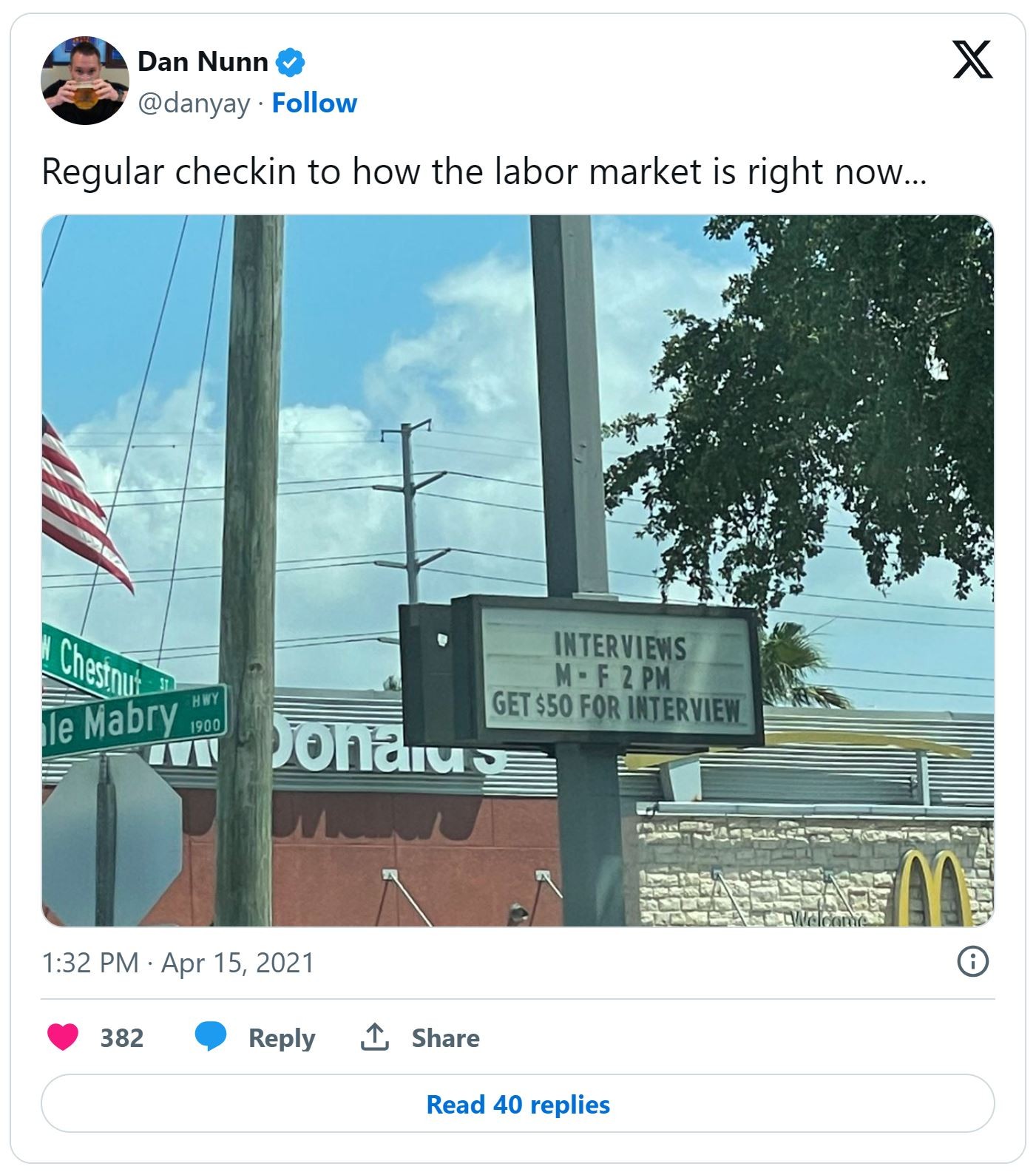In my daily skim of the news, I saw a tale of two economies: one booming and one cooling down. Check out this quote from US News and World Report.
U.S. employers posted 8.7 million job openings in October, the fewest since March 2021, in a sign that hiring is cooling in the face of higher interest rates yet remains at a still-healthy pace.
The Labor Department’s report said Tuesday that openings were down significantly from 9.4 million in September.
Layoffs were up modestly in October. And the number of Americans who quit their jobs – which generally reflects confidence in their ability to find better pay or working conditions elsewhere — was down slightly.
And on the flipside, you have a report that McDonald’s plans to open 10,000 new stores over the next 4 years. Here’s a quote from El Pais…
At an investor update Wednesday, the Chicago burger giant said it aims to have 50,000 restaurants in operation worldwide by the end of 2027. McDonald’s had 40,275 restaurants at the start of this year.
It plans to open 900 new stores in the U.S. and 1,900 in some of its bigger international markets like Canada, Germany, the United Kingdom and Australia. The company said it plans another 7,000 stores in other international markets; more than half of those would be in China.
Whether or not we are in a recession, it certainly feels that way. I hope I’m wrong and if I am, McDonald’s is going to have a challenge staffing all their locations in America. There are several reasons why. Among them…
- Minimum wage laws: Many cities and states have increased their minimum wage rates, making it more expensive for fast food restaurants to hire workers. One example of this is the city of Seattle, which increased its minimum wage to $15 per hour in 2015. This increase had a significant impact on the fast food industry, as many restaurants were forced to raise their prices or reduce their staff sizes in order to maintain profitability. Some restaurants even closed down entirely, citing the increased cost of labor as a major factor.
- Lack of benefits: Many fast-food jobs do not offer benefits such as health insurance, paid time off, or retirement plans, which can make them less attractive to potential employees. This is because some employers hire low-wage workers in part-time roles, which exempts them from the requirement to offer health insurance under the Affordable Care Act.
- Turnover: According to the U.S. Bureau of Labor Statistics, the annual average employee turnover rate across all industries is between 12-15%. However, in some fast-food businesses, such as quick-service restaurants (QSRs), they routinely experience 150% annual staff turnover.
The challenges mentioned earlier are not confined to the recruitment of fast-food workers alone. Frontline staff in various sectors, including retail stores, restaurants, call centers, and warehouses, encounter similar constraints. Beyond the factors already mentioned, the presence of a significant number of older workers in the job market, limited opportunities for career advancement, and the negative stereotypes associated with certain hourly jobs (such as fast food) further complicate the process of hiring in large volumes. Despite these obstacles, I became curious about the approaches companies employ to address these challenges and successfully execute high-volume recruitment. So, I looked into it, and I discovered numerous examples of effective high-volume recruiting strategies both within and outside the fast-food industry.
ROBOTS AND AUTOMATION
McDonald’s has been testing automated drive-thru service at a location near Fort Worth, Texas. The restaurant features an automatic conveyor belt that delivers drive-thru orders, and the ordering process is done through kiosks or an app, with no human involvement in the order-taking process. This initiative is part of McDonald’s commitment to finding new ways to serve customers faster and easier. While the automated drive-thru has received mixed reactions from customers, McDonald’s has stated that the technology allows its human kitchen staff to prepare customer orders more efficiently, ultimately enhancing the overall customer experience.
There is a hotel in Japan that has reduced their staffing issues by employing robots and automating their customer experience. Henn-na Hotel, the world’s first hotel entirely staffed by robots, opened in Nagasaki, Japan on July 17, 2015. The robots, including an English-speaking dinosaur robot, assist with the check-in process, carry luggage, and provide other services. While a human staff is also available 24/7, the robots make up the primary staff of the hotel.
Three years ago, a futuristic restaurant in south China has 46 different kinds of robot cooks, deliver food, and place orders for diners.
SIGN-ON BONUSES
Offering sign-on bonuses has been a consistent trend for hiring a high-volume of workers. And why not, it certainly works. The use of sign-on bonuses has become prevalent, with some job ads offering sign-on bonuses increasing by over 450% between August 2020 and August 2021. As Jerry Maguire famously said, “Show me the money!”

- Customer Service jobs with sign on bonuses – 37,429 nationally.
- Delivery Driver jobs with sign on bonuses – 1,466 nationally
- Warehouse worker jobs with sign on bonuses – 3,793 nationally
- Dishwasher jobs with sign on bonuses – 454 jobs
RECRUITMENT OPTIMIZATION
The Body Shop introduced a pilot program at a distribution center in Wake Forest, N.C., to remove nearly every hiring requirement, from drug tests and background checks to education and work experience. I think this is a bold step but, if it works, it works. Here’s a quote from the Wall Street Journal.
In 2019, when the U.S. unemployment rate hovered around 3.6%, The Body Shop introduced a pilot program at a distribution center in Wake Forest, N.C., to remove nearly every hiring requirement, from drug tests and background checks to education and work experience.
The company said it was trying to address inequality by opening positions to workers seeking a second chance or needing extra support. More than 200 seasonal employees came aboard.
Last year, The Body Shop expanded open hiring to all seasonal entry-level retail jobs. Since its launch, the rate of performance-related terminations of people hired in the pilot program has been about the same as the rate among people hired through the routine screening process, said Nicolas Debray, The Body Shop president for the Americas.
Open hiring became the model for all of the company’s entry-level retail and warehouse hires this year. By mid-September, 733 employees had joined the company this way, and 80 joined the company’s permanent staff. Under the system, recruiters ask candidates only if they are legally authorized to work in the U.S.; whether they can lift 25 pounds (50 pounds for distribution center work) and work an 8-hour shift. For retail jobs, applicants are asked why they want to work with customers.
As daring as that approach was, The Body Shop was following the example of Greyston – a bakery whose customers include Whole Foods and Ben & Jerry. Fast Company reported on the initiative this way…
When there’s an opening, the job is filled from a list of people looking for work. New hires start as apprentices and get training in both how to do the job and basic life skills; those who decide to stay after the apprenticeship get an entry-level job and the opportunity to advance. The system works well enough that the company sold 8 million pounds of brownies in 2019, making $22 million. This year, Greyston launched a nonprofit, the Center for Open Hiring, in 2018 to help other businesses implement the same process.
SPEEDY HIRING
If removing all requirements is a bridge too far, there is an efficient in-between place as demonstrated by Darden Restaurants Inc., the parent of Olive Garden. As reported by the Wall Street Journal, Darden rolled out a new tool that allows people to apply for a job and schedule an interview at its restaurants within five minutes. Similar tactics have been initiated by Waste Management Inc. which has a job application that takes three minutes to fill out. And if it is possible to shorten the process even further, Southwest Airlines Co. makes on-the-spot offers for ramp workers and other positions. Also noteworthy is UPS who eliminated job-application questions and hiring steps unless they were required for payroll purposes and government audits. For some jobs, such as driver helper, there is no interview at all. Applicants answer online questions and can get a conditional job offer in as little as 10 minutes.
STRATEGIC ALLIANCES
While I have not heard of anyone doing this, I suspect that this would be an effective resolution to volume hiring for several small businesses. In a nutshell, its this, create alliances with non-competitors. Create the option to get one check from working within the newly formed partnership. On Monday, a worker could work in a warehouse, on Tuesday, that same worker could be delivering packages, on Wednesday, the worker is in a call center, and so on. In this way, the worker can do something different each day or week.
What am I missing?
Robots and automation, sign-on bonuses, recruitment optimization, and speedy hiring are not the only to hire hourly workers in bulk, but it’s a start. What am I missing? Let me know by sharing this article on social media and commenting on a clever strategy I overlooked. I want to hear from you.
